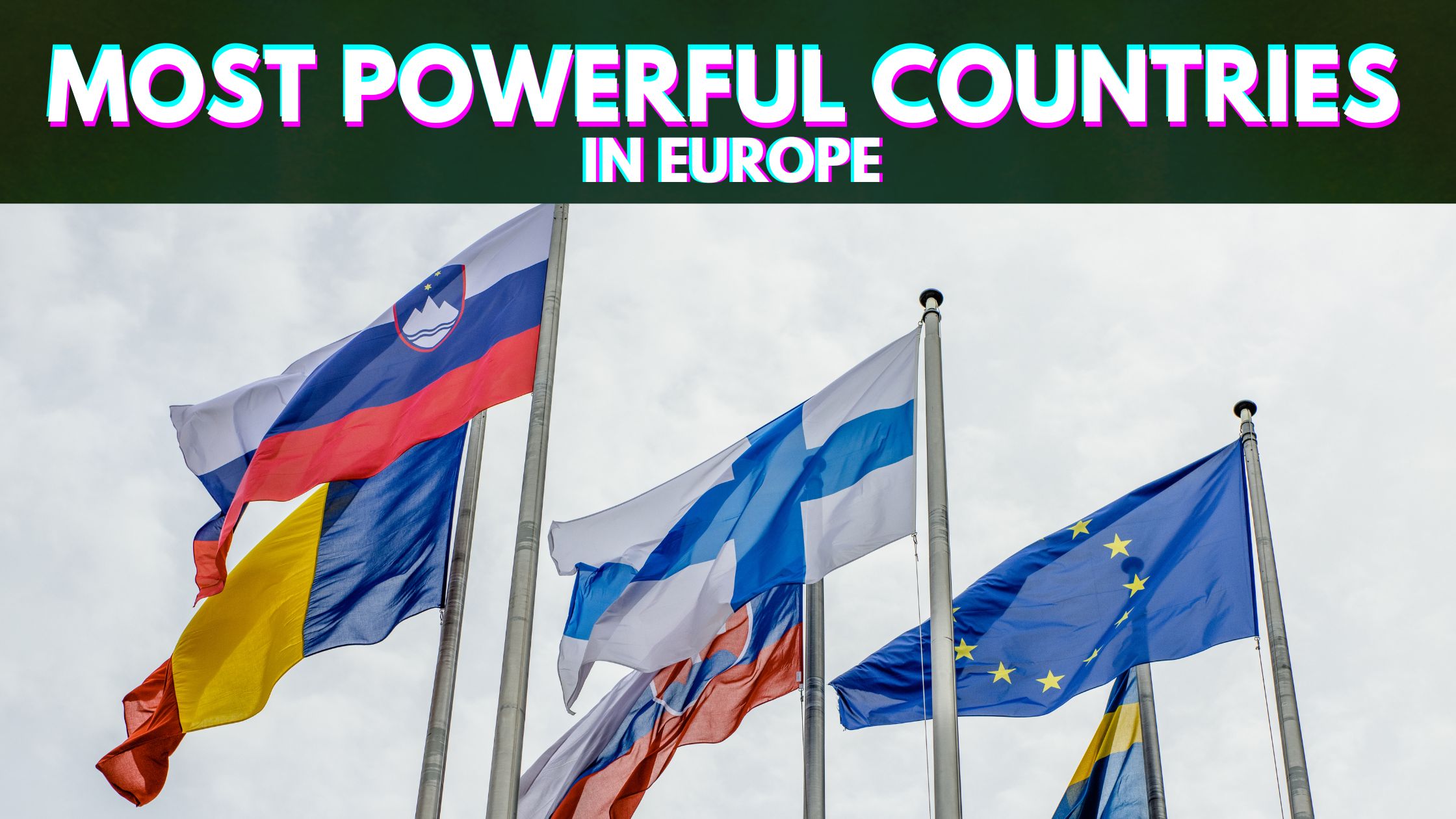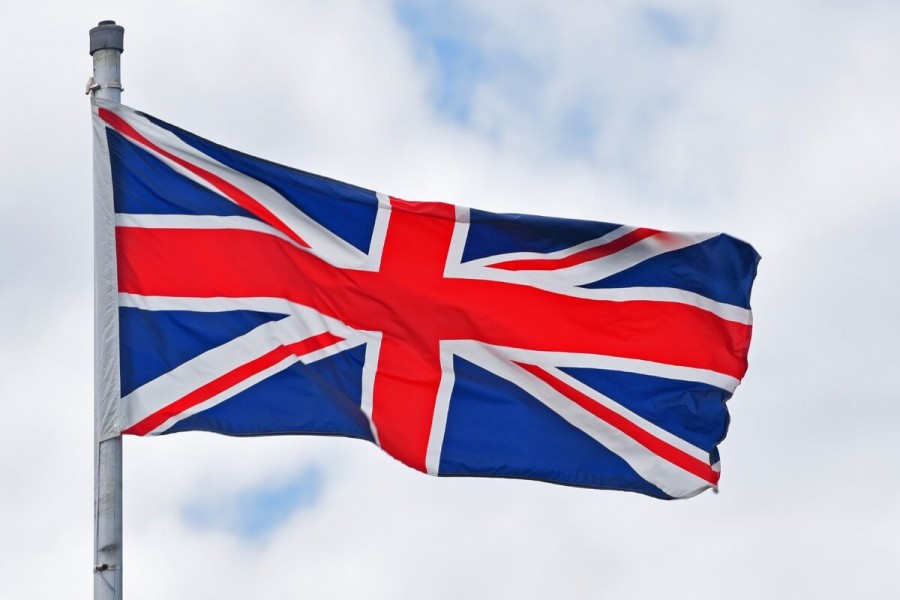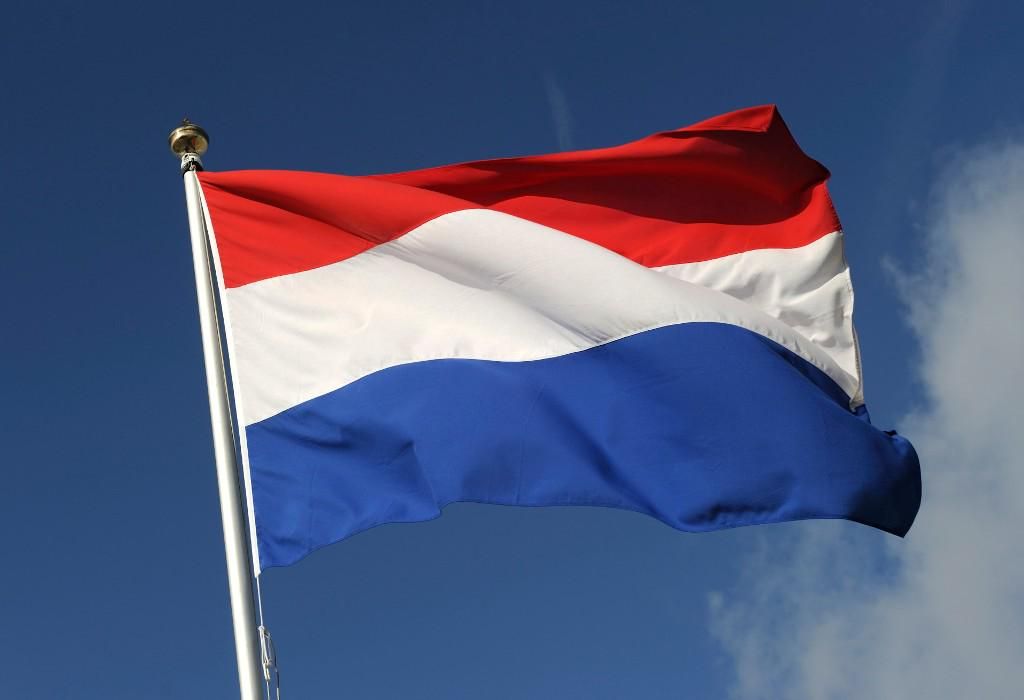Top Lists
Top 10 Most Powerful Countries in Europe (2022)
Below are the top 10 most powerful countries in Europe.

Europe is a continent with a long and proud history. For centuries, it has been the center of politics, culture, and economics. Today, it is no different. Europe is home to some of the most powerful countries in the world.
In this blog post, we will explore the most powerful countries in Europe. From their economic might to their political influence, these countries are leaders on the continent and beyond. Read on to learn more about the most powerful countries in Europe.
1. Germany
Capital: Berlin
Dialing code: +49
President: Frank-Walter Steinmeier
Currency: Euro
Official language: German
Germany is one of the most powerful countries in Europe and it is the first on the list.
It is a Western European nation with a landscape made up of rivers, mountains, forests, and beaches along the North Sea.
Germany’s economy is a very advanced social market economy. Its national economy is the biggest in Europe, the fourth largest by nominal GDP worldwide, and the fifth largest by GDP (PPP).
It has a reputation for being highly innovative and having a low level of corruption. It is the world’s third-largest importer and exporter of goods. The development of Germany’s economy has benefited a number of high-growth industries, including the production of automobiles, mechanical and plant engineering, the chemicals industry, and medical technology. Exports account for well over half of total sales.
Its history spans more than two millennia. Its capital, Berlin, is home to vibrant art and nightlife scenes, the Brandenburg Gate, and numerous WWII-related landmarks. The European Central Bank is situated in the skyscraper-filled city of Frankfurt.
Germany is a well-organized, highly developed nation. The country’s infrastructure is good, everything runs on time, and there is respect for the environment. Cities are typically walkable, and the nation’s efficient mass transit system makes getting around easy.
Germany is ranked first because of its strong economy, international stature, and focus on crucial global issues like the migrant crisis and eurozone cohesion.
2. The United Kingdom
Queen: Queen Elizabeth II Trending
Capital: London
Dialing code: +44
Currency: Pound sterling
The United Kingdom is an island country in northwest Europe made up of England, Scotland, Wales, and Northern Ireland. Shakespeare and The Beatles were both born in England, and London, the country’s capital, is a major hub for finance and culture on a global scale. The Neolithic Stonehenge, the Roman spa at Bath, and the historically significant universities of Oxford and Cambridge are all located in England.
The UK is one of the top 10 powerful countries in Europe, with a GDP of $2.7 trillion. The sectors with the largest GDP contributions in the UK are services, manufacturing, construction, and tourism. The UK has many peculiar laws, including one called the free asset ratio. one of the UK economies with the greatest interconnection. In 2019, it was the fifth-largest exporter and importer in the world.
It also had the third-largest inward and fifth-largest outbound foreign direct investments. The financial services industry is particularly significant, with London being the second-largest financial hub worldwide.
3. France
Capital: Paris
Dialing code: +33
President: Emmanuel Macron
Currencies: Euro, CFP franc
Official language: French
France is a country in Western Europe that includes Mediterranean beaches, alpine villages, and medieval cities. Its capital, Paris, is renowned for its designer boutiques, museums of classical art, such as the Louvre, and landmarks like the Eiffel Tower.
The nation is renowned for its fine cuisine and wines as well. Its lengthy history is attested to by Lascaux’s prehistoric cave paintings, Lyon’s Roman theater, and Versailles’ enormous Palace.
France is categorized by the World Bank as a wealthy, high-income country. The French people rely on the federal government to provide social services like retirement pensions, health care, and education.
The country has a very diverse economy. The three primary industries that makeup France’s diverse economy are tourism, manufacturing, and the pharmaceutical sector. Despite the partial or complete privatization of many large corporations, the government continues to play a significant role in sectors like power, public transportation, and defense.
It would be difficult to overstate France’s significance in world history and current affairs. France, one of the oldest nations on earth and a part of Western Europe, has a significant influence on international politics, the economy, science, and, perhaps most significantly, culture.
With a GDP of $2.6 trillion, France has the third-strongest economy in Europe. France takes pride in being one of the most developed nations in the world and a leader among the European nations.
4. Italy
Capital: Rome
Dialing code: +39
Currency: Euro
President: Sergio Mattarella
Official language: Italian
Italy is one of the top 10 most powerful countries in Europe, it is the 31st safest country in the world.
Italy is a Mediterranean-coastal nation in Europe and has had a significant influence on Western culture and cuisine. The Vatican, as well as famous artwork and historic ruins, can be found in the country’s capital, Rome. Other significant cities include Milan, Italy’s fashion hub, Venice, the city of canals, and Florence, home to Renaissance masterpieces like Michelangelo’s “David” and Brunelleschi’s Duomo.
The Renaissance and the outstanding artists it produced made Italy famous. Italy is renowned for its tourism, art cities, and distinctive landscapes.
Italy is renowned for its fashion, language, opera, and high-end brands. It is renowned for its football team as well!
With a $1.9 trillion economy, Italy ranks fourth in Europe. Italy has significant economic strengths despite low productivity growth and problems with price competitiveness within the eurozone, which may sound strange to northern European ears.
It continues to be the second-largest EU destination for industrial production, after Germany, largely because of the economic structures in the northern regions. It ranks third in exported goods, just behind France, and dominates in mechanical engineering, vehicle construction, and pharmaceutical products.
The market economy in Italy is very developed. It has the third-largest GDP in the European Union, the eighth-largest national economy in the world by nominal GDP, and the thirteenth-largest overall (PPP). Italy became a member of the EU at its inception.
5. Russia
Capital: Moscow
Dialing code: +7
President: Vladimir Putin
Currency: Russian ruble
Official language: Russian
Azerbaijan, Belarus, China, Estonia, Finland, Georgia, Kazakhstan, North Korea, Latvia, Lithuania, Mongolia, Norway, Poland, and Ukraine are among the 14 nations that Russia borders.
In reality, Russians are warm, welcoming, and helpful people. Russia has a lot to offer, whether new arrivals enjoy the outdoors or prefer the conveniences of city life. In Russia, especially in the major cities, there are numerous social events and sporting opportunities.
The country is the third-largest oil producer in the world, behind Saudi Arabia and the US. This nation produced 11% of the oil used in the world. Among the largest oil and gas companies in Russia are Rosneft, Lukoil, and Surgutneftegas.
The planned economy of Russia has gradually given way to a market-oriented one. Two of their numerous natural resources are oil and natural gas. It is the fifth-largest economy in Europe and ranks sixth globally in terms of nominal GDP and purchasing power parity (PPP). Russia has typically been referred to as an energy superpower because it has the largest natural gas reserves in the entire world. Russian oil production exceeds that of its natural gas.
Continue Reading: Top 10 Most Powerful Countries in Asia
6. Spain
Capital: Madrid
Dialing code: +34
Currency: Euro
Official language: Spanish
There are 17 autonomous regions within the nation of Spain, which is located on the Iberian Peninsula in Europe. The Royal Palace and Prado museum, which houses works by European masters, are located in Madrid, the country’s capital. Both a Roman aqueduct and a medieval castle from the Middle Ages can be found in Segovia. Barcelona, the capital of Catalonia, is known for its whimsical modernist structures like the Sagrada Familia church.
Spain is renowned for its laid-back lifestyle, delectable cuisine, and breathtaking scenery. Major cities with distinctive traditions, languages and must-see locations include Madrid, Barcelona, and Valencia. Bright festivals like La Fallas and La Tomatina draw large crowds of people from both the local community and tourists.
Spain has a mixed-capitalist economy. According to the World Bank, Spain is one of the countries with a very high level of human development and a high-income economy.
Spain is one of the European countries with a mixed-capitalist economy. Spain has the sixth-largest economy in Europe, with a GDP of $1.2 trillion, behind only Germany, the United Kingdom, France, Italy, and Russia. In addition to importing goods like fuel, chemicals, semi-finished goods, food, and consumer goods, Spain is a significant exporter of goods like machinery, automobiles, food, pharmaceuticals, and medications. Spain has a highly developed social market economy. By purchasing power parity, it ranks among the top economies in the world, and by nominal GDP, it is the fourteenth largest.
7. Netherland
Capital: Amsterdam
Dialing code: +31
Currency: Euro
Continent: Europe
Official language: Dutch
One of the most powerful countries in Europe is Netherland, it is renowned for its flat terrain that is covered in canals, tulip fields, windmills, and cycling paths.
The Rijksmuseum, the Van Gogh Museum, and the house where Jewish diarist Anne Frank hid during World War II are all located in Amsterdam, the country’s capital. From the city’s “Golden Age” in the 17th century, canalside mansions and a collection of artwork by Rembrandt and Vermeer are still standing.
The Netherlands is among the richest countries in the European Union, Despite being a small nation, The Netherlands is home to many well-known figures from around the world.
Despite having a heavily mechanized agriculture industry that only employs 2% of the labor force, the Netherlands has the seventh-strongest economy in Europe. The food-processing industry receives a large portion of the agriculture sector’s large surpluses, which are then exported.
Since 1959, the Netherlands has consistently had access to natural gas supplies, in addition to the significant GDP contribution made by the agricultural industry. The Netherlands currently holds more than 25% of the natural gas reserves in the EU. Over the ensuing decades, the sale of natural gas resulted in a significant increase in revenue, which significantly boosted the Netherlands’ GDP.
8. Switzerland
Dialing code: +41
Currency: Swiss franc
Continent: Europe
Official languages: German, French, Italian, Romansh
Switzerland is a mountainous nation in Central Europe that is home to many lakes, towns, and the lofty Alps. Medieval neighborhoods can be found in its cities, including the Zytglogge clock tower in Bern, the nation’s capital, and the wooden chapel bridge in Lucerne.
The nation is renowned for its hiking trails and ski resorts. Key industries include banking and finance, and Swiss goods like watches and chocolate are well-known worldwide.
Because of a favorable investment environment, strong public finances, and a low strike frequency, the Swiss economy is prosperous and stable. Even during the COVID-19 crisis, Switzerland’s national debt remained low in comparison to that of other nations.
Before subtracting financial assets, the gross governmental debt at the start of 2021 was roughly CHF 100 billion, or 15% of GDP. The Swiss economy is strong in large part due to its international reach and close ties to the economies of other countries. Switzerland has one of the highest export rates relative to its GDP. Purchase power is kept stable by low long-term capital costs and historically low inflation.
It is one of the most powerful countries in Europe.
9. Turkey
Capital: Ankara
Dialing code: +90
Currency: Turkish lira
President: Recep Tayyip Erdoğan
Official language: Turkish
Continent: Europe, Asia
Turkey, formally the Republic of Türkiye, is a transcontinental nation with the majority of its territory in Western Asia’s Anatolian Peninsula and a small portion in Southeast Europe’s Balkan Peninsula.
Turkey ranks ninth among the 10 economies expected to experience the highest growth in Europe in 2022, with a GDP of $720.1 billion.
Turkey’s economy is relatively open and has a sizable manufacturing and service sector. Manufacturing automobiles, petrochemicals, and electronics are significant industries.
Political unrest, involvement in local armed conflicts, and some turbulence in the financial and currency markets have all recently hampered Turkey’s economy. The country ranks among the top producers of agricultural products, textiles, cars, trucks, building materials, consumer electronics, and home appliances worldwide.
10. Poland
Capital: Warsaw
Dialing code: +48
President: Andrzej Duda
Currency: Polish złoty
Continent: Europe
Official language: Polish
Poland is a nation in Central Europe and is formally known as the Republic of Poland. It has a total area of 312,696 km2 and is divided into 16 administrative provinces known as voivodeships. Poland is the fifth-most populous member of the European Union with a population of over 38 million.
Poland completes the list of the top 10 most powerful countries in Europe for 2022. Poland’s economy is industrialized, mixed, and has a developed market. It ranks fifth in the European Union in terms of GDP and sixth in terms of nominal GDP (PPP). Since 1988, Poland has been working to liberalize its economy. This is the most prosperous post-communist state there is.
As of November 2013, Poland’s economy had expanded by a total of 16 percent, while the EU’s GDP was still lower than it was before the crisis. The main factors behind its success appear to be its sizable internal market and a business-friendly environment.
Summary
More than 50 countries can be found within the boundaries of Europe. Europe is home to some of the richest nations in the world.
Here is a summary list of the top 10 most powerful countries in Europe:
- Germany
- The United Kingdom
- France
- Italy
- Russia
- Spain
- Netherland
- Switzerland
- Turkey
- Poland
Read More:










